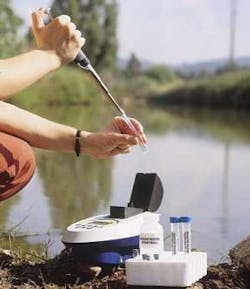Monitoring System Provides Early Detection of Water Contamination
CheckLight – part of the Whitewater Technology Group, a company based in Israel – has introduced to the US market a new water monitoring system that uses non-pathogenic luminous marine bacteria as early-detection sensors. The system provides real-time, online monitoring, and the system can be expanded by simply adding more monitoring units.
The technology has been verified by the US Environmental Protection Agency’s ETV program. It is sensitive to very low concentrations of a wide range of toxic chemical agents and requires minimal maintenance and on-site visits. A report on the ETV testing can be found on the EPA website at www.epa.gov/etv. Search for Checklight ToxScreen.
CheckLight’s technology uses natural luminescent bacteria as early-warning biosensors, positioned inside the monitoring stations. If water is contaminated, the bacteria react by reducing the amount of emitted light, which generates an automatic contamination alert. The benefit of this technology is that, rather than monitoring and analyzing the changing values of various parameters, bacteria respond directly in real time to a wide range of dangerous contaminants by simply dimming or turning off the light.
On the negative, the system does not provide specific information about the contaminant.
A number of other monitoring systems are available on the market, including chemical and biological systems. According to a CheckLight spokesman, one disadvantage of chemical monitoring devices is their inability to detect and analyze the combined effects of subtle changes in multiple contaminants, each of which may be within its own acceptable limits.
For example, if two values change, but neither of them alone is sufficient to set off an alert, then even if the combination of the two will cause contamination of the water, a chemically based solution will not detect the hazard.
The biological monitors currently on the market are based on living entities such as algae, clams, or fish, thereby overcoming some of the difficulties inherent in the chemical monitoring devices. However, these solutions require considerably more maintenance than the bacteria used in the Checklight system.
Along with it’s automated systems, CheckLight also sells manual kits for detecting water contamination. It’s portable ToxScreen water toxicity test provides on-site detection of a wide range of acute and chronic organic and inorganic toxicants. It’s AOC test determines assimilable organic carbon, either in drinking water or seawater, within just 120 minutes, and a Biochemical Oxygen Demand test determines the existence and concentration of oxidizable and biodegradable organic compounds in water networks within a period of 3-4 hours (instead of 5 days).
The Whitewater Technology Group, founded in 2006, has been active in acquiring Israeli companies that serve the water utility industry in the areas of monitoring and early warning, water security, drilling efficiency, and water controllers.
Additional members of the Whitewater Technology Group are: Whitewater Security (water security), Galcon Computerized Control Systems (water controllers), and Whitewater Well (water drilling). Whitewater will be exhibiting it’s technologies at WEFTEC ‘08 and plans to bring those technologies to the US water market. WW

